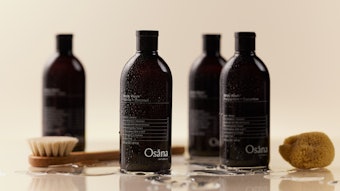With global sales of $23.3 billion in 2005 and growth of almost 6% on the previous year, bath and shower appears to be picking up the pace and taking advantage of the opportunities in emerging markets. In developed markets, where competition is toughest, manufacturers are innovating to drive value sales and find a unique selling point that will give their brands an edge.
Rising Sophistication: Latin America and Eastern Europe
In 2005, bath and shower products saw rapid expansion in Latin America, albeit from a small base and accounting for less than 11% of total global value sales. By 2010, the region is expected to experience value growth of 15%, a slight comedown from the 2001–2005 period (17%) but nonetheless dynamic. Bar soap has commonly been the main driver of sales—accounting for almost 85% of sector value in 2005, a 17% growth, and outselling value-added liquid soap and body wash varieties—but this is beginning to change. As in other developed markets, the most dynamic area for Latin America in 2005 was body wash/shower gel with 26% growth, reflecting the increasing popularity of the format perceived as more convenient and luxurious among affluent urban consumers.
Eastern Europe represents strong growth prospects in the bath and shower products sector, as economic conditions across the region improve and the market consistently returns dynamic year-on-year value sales. Eastern Europe is also showing real signs of sophistication, and consumers have proved to be willing to pay more for luxury items such as bath additives and value-added shower gels. Staple bar soap, as well, continues to expand in value terms—with products such as Dove’s array of “one quarter moisturizing cream” products offering more for slightly higher unit prices.
Russia, Ukraine and Poland are the largest markets in the region, accounting for 29%, 23% and 15% of value sales, respectively, in 2005. In Russia and Ukraine, recent years were marked by the growing availability and popularity of more sophisticated bath and shower products such as bubbling bath salts, sparkling tablets, at-home spa sets and products made from natural ingredients.
Consumers in the region increasingly strive for the same luxury products enjoyed by their Western counterparts—due, in part, to their increased exposure to Western advertising and media imagery. In Poland, the Czech Republic and Hungary, bar soap is still considered a household staple, but value growth in bar soap has suffered from value-added product and liquid format sales.
Two-tiered Market: Asia-Pacific
Japan, India and China lead the bath and shower products sector in Asia-Pacific, accounting for 30%, 22% and 18% of regional sales, respectively, in 2005. The sector is mature in Japan, and the slowing growth has forced marketers to focus on adding value to retain an edge. India and China, on the other hand, are underdeveloped with huge growth prospects, and the emphasis is on raising penetration rates.
A major value generator with a modest upturn in 2005, Japan proved not to be the drag on Asia-Pacific’s growth that it had been in previous years (when growth was viewed in local currency terms). However, the country’s bath and shower products sector is not out of the woods yet. Sales of talcum powder, liquid soap and bar soap all declined in 2005 due to falling birth rates, commoditization and strong price competition; though, as in other developed countries, body wash/shower gel was the one sector that showed strong value gains. The sector benefited from the development of pampering at-home spa and aromatherapy variants—such as Lux Spa Moist Orange Bloom Body Soap by Unilever, launched as a Japanese brand extension in 2005.
In India, value growth is being driven by bar soap. Manufacturers are dropping pack sizes to reduce unit prices, thereby bringing products within the reach of the country’s less affluent majority. There also is a push to widen penetration to India’s rural poor. Unilever’s Swasthva Chetna (“health-awakening”), launched in partnership with the Indian government, teaches the importance of hand washing in approximately 18,000 villages (in eight states) and reaches 70 million rural dwellers. Bar soap sales in India rose by almost 7% in 2005 to $1.1 billion.
In the country’s more affluent western states, body wash/shower gel is beginning to find demand, although it remains nascent with sales of just $9 million (or less than 1% of total bath and shower products sales) in the country as a whole. The importance of India as a region for multiproduct growth will wane as consumers continue to focus their spending on bar soap and talcum powder—two areas with limited scope for value-adding innovations.
Looking forward, China will continue to top Asia-Pacific growth tables, even as Indonesia is expected to emerge as a dynamic new market—with potential coming from its improved economy, political stability and large population base—through 2010. South Korea is also a key market to watch, being relatively undeveloped in bath and shower products despite having a large and relatively affluent population.
Mature Markets Show Sluggish Growth
Although Western Europe and North America currently account for a vast proportion of global value sales, the maturity of bath and shower products in these developed economies leaves little room for volume growth. In addition, increased competition puts pressure on prices, limiting opportunities for value gains. New product launches offer functional benefits, problem-solving formulations, and convenience and portable formats. Segmentation by age and gender is also a way for players to justify higher prices, as is the incorporation of natural ingredients and aromatherapy.
In North America in 2005, minimal value growth of 2% was driven by the dynamic body wash/shower gel product area (which itself grew by 10%). Specialist stores selling premium products, such as Bath & Body Works and The Body Shop, helped spur growth. Natural and organic ingredients are big draws for bath and shower products in North America, but, conversely, so are highly efficacious offerings such as antibacterial liquid soaps. Such innovation helped offset a 3% decline in bar soap, attributed to increased competition from liquid soaps for hands and the growing retail presence of bar soap alternatives in price-competitive mass-market retailers. In terms of segmentation, men were the new target, and after intense new product development, Unilever introduced a male-specific grooming line that included bath and shower items under its Axe brand.
Faster growth in both Australasia and Western Europe between 2001 and 2005 was stimulated by regional economies more buoyant than North America’s. This growth was further aided by successful product development. The U.K., Italy, Germany and France were the largest markets in Western Europe in 2005, but also the poorest performers in terms of value sales growth—due in part to the threat of low-priced private label offerings. In the U.K., new innovations focused primarily on pampering and attracting male consumers. The mega brand trend was also in evidence, with brands leveraging their popularity by expanding their presence. Unilever branched out its bath and shower brand Lux into liquid soap in July 2005, and made a similar move again in August by building on the success of Sure deodorant, and introducing the brand into body wash/shower gel for the first time.
Take Local Preferences into Account
Euromonitor International observes that differing national bathing preferences is a key factor impacting demand for bath and shower products across the globe. In Japan and the developed Western markets, hygiene regimens are fastidious and usage is heavy. There also are competing demands—for elaborate, pampering treatments as well as time-saving and portable products. In the hotter climates of Latin America, consumers also put a strong focus on personal hygiene, with some Brazilian consumers bathing up to three times a day. However, lower levels of disposable income in this region keep spending trained on economical bar soap. Added-value liquid variants are a dynamic but comparatively tiny niche. India, on the other hand, while relatively underdeveloped, has a strong tradition of using talcum powder in place of deodorants, making this the largest single-country market for the subsector.
Country-to-country variations in bath and shower products usage are expected to become less noticeable in the long term—as the spread of Western hygiene norms and rising global affluence kick-start demand in less developed markets. The previously mentioned hand washing campaign in India and similar educational campaigns have been successfully undertaken in underdeveloped communities, but education is not the only factor to penetrating these markets. Keeping unit prices down is also important in making products accessible to low-income populations. Maintaining smaller unit sizes—cost-effective sachet-sized versions, for example—is key to maintaining low unit prices. Modernization of distribution will also lift sales, making products more visible and accessible and increasing access to Western brands.
Innovation and New Niches Vital to Success
One of the primary ways to boost value in bath and shower products is through pampering benefits. At-home spa treatments featuring aromatherapy and natural ingredients are common, and organics are now appearing in this segment. Use of food ingredients is another emerging trend, with the moisturizing properties of olives, avocado, milk and honey and the energizing benefits of orange, mango and papaya proving particularly popular. Pampering, however, is not achieved strictly through formulation, but delivery, as well. BubbleGel, for example, comes in individual capsules combining foaming agents and essential oils.
As the boundary between bath and shower products and skin care becomes blurred, manufacturers must look to other sectors for inspiration. Antiaging, firming and anti-cellulite are among the claims appearing on body wash/shower gel (e.g. Eris Lirene Anti-Cellulite Shower Gel). Moisturizing and exfoliating brands are even more established—notably the Dove range with a formulation of one quarter moisturizing cream and L’Occitane Lavender Blackberry Exfoliating Shower Gel.
As commoditization increases, product segmentation must become increasingly advanced. For consumers who enjoy sporting lifestyles, to cite one particular target group, convenience formats and strong-acting, refreshing formulations are becoming the norm, with products such as Avon Pro Sport for Men and Liz Sport for Women shower gels.
Pressure to add value to bath and shower products is set to continue to 2010. Efforts to boost penetration among the world’s developing markets will speed the rate at which saturation is achieved. However, it is the emerging middle classes that are proving willing to trade up as they aspire to the comforts and convenience of Western living. Many bath and shower products are also latching onto the health and wellness trend—offering consumers a way to take care of themselves as well as affording an opportunity for guilt-free indulgence. In the longer term, therefore, adding value is expected to continue as the focus of new product launches. Increasing the occasion for usage—adding nighttime brand extensions, for example—is one strategy already being explored.
Manufacturers are also likely to boost efforts to gain credibility in the at-home spa segment. In November 2006, U.K. supermarket chain Tesco launched a professional spa bath and body range under television health, fitness and well-being expert Jasmine Harman. The line, called Body Therapy Spa, is due to appear in leading Tesco stores beginning February 2007, and is divided into four distinct ranges. Other mass brands, including Simple and Nivea, are moving into the spa channel—illustrated by the 2006 opening of Simple:SPA in London and Nivea Haus in Hamburg, Germany. Natural and organic ingredients have already permeated bath and shower products, and environmentally friendly formulations—a trend spurring innovation elsewhere in cosmetics and toiletries—could appear in bath and shower products in the near future in the form of biodegradable foams, refillable or recyclable packaging or the use of sustainably sourced ingredients. Products that cut down on water use, such as evaporating antibacterials, could also prove popular with consumers increasingly interested in green products.










